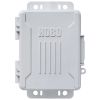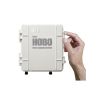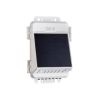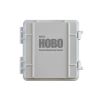HOBO ECH2O EC-5 Soil Moisture Smart Sensor
Features
- Measures a 0.3-liter volume of soil
- High-frequency (70 MHz) circuit provides good accuracy even in high-salinity and sandy soils
- Compatible with Onset stand-alone and web-based weather stations
- Free ground shipping
- Expedited repair and warranty service
- Lifetime technical support
- More
Overview
The Onsite ECH2O EC-5 soil moisture smart sensor offers a two-tine design for easy installation in in an affordable package. This sensor integrates the field-proven ECH2O EC-5 Sensor and a 12-bit A/D. It provides ±3% accuracy in typical soil conditions, and ±2% accuracy with soil-specific calibration. Readings are provided directly in volumetric water content. This sensor is designed to maintain low sensitivity to salinity and textural effects.
Measurement Range
In soil: 0 to 0.550(m³/m³)
Extended range: -0.401 to 2.574 m³/m³ (full scale)
The sensor is capable of providing readings outside the standard volumetric water content range. This is helpful in diagnosing sensor operation and installation. See User Manual for additional information.
Accuracy: ±0.031 m³/m³ (±3.1%) typical 0 to 50°C (32° to 122°F); ±0.020 m³/m³ (±2%) with soil specific calibration.
This is a system-level accuracy specification and is comprised of the ECH2O probe's accuracy of ±0.03 m³/m³ typical (±0.02 m³/m³ soil specific) plus the smart sensor adapter accuracy of ±0.001 m³/m³ at 25°C (77°F). There are additional temperature accuracy deviations of ±0.003 m³/m³ / °C maximum for the ECH2O probe across operating temperature environment, typical <0.001 m³/m³ / °C. (The temperature dependence of the smart sensor adapter is negligible.)
Resolution: 0.0007 m³/m³ (0.07%)
Soil probe dimensions: 89 x 15 x 1.5 mm (3.5 x 0.62 x 0.06 in.)
Weight: 180 grams (6.3 oz)
Decagon ECH2O probe part No.: EC-5
Sensor operating temperature: 0° to 50°C (32° to 122°F).
While the sensor probe and cable can safely operate at below-freezing temperatures (to -40°C/F) and up to 75°C (167°F), the soil moisture data collected at these extreme temperatures is outside of the sensor's accurate measurement range.
Volume of influence: 0.3 liter (10.1 oz)
Sensor frequency: 70 MHz
Bits per sample: 12
Number of data channels: 1
Note: A single smart sensor-compatible HOBO logger can accommodate 15 data channels and up to 100 m (328 ft) of smart sensor cable (the digital communications portion of the sensor cables)
Measurement averaging option: No
Cable length available: 5 m (16 ft)
Length of Smart Sensor network cable: 0.5 m (1.6 ft)
In The News
Supplying Seattle’s Drinking Water: Using Data Buoys to Monitor the Cedar River Municipal Watershed
Providing clean, safe, and reliable drinking water for the 1.6 million people in the greater Seattle area is a top priority for Seattle Public Utilities (SPU). With limited water supplies, SPU dedicates considerable resources to maintain its watersheds and mountain reservoirs. About 70 percent of Seattle Water comes from the Cedar River Municipal Watershed , and the other 30 percent comes from the South Fork Tolt River Watershed . [caption id="attachment_39574" align="alignnone" width="940"] Data buoy in Chester Morse Lake . (Credit: Kevin Johnson / Seattle Public Utilities) [/caption] Jamie Thompson, a fisheries biologist at SPU, monitors aquatic ecosystems centered on fish listed under the U.S. Endangered Species Act (ESA).
Read MoreData-Driven Advocacy on the Lower Deschutes River
Like many freshwater environments, the Deschutes River in Oregon is under pressure from development, pollution, and climate change. Many rivers, streams and lakes in the Deschutes Basin do not meet Oregon water quality standards –where state water quality monitoring assesses levels of bacteria, pH, dissolved oxygen, temperature, and fine sediment. Hannah Camel is the Water Quality Coordinator for the Deschutes River Alliance (DRA), a non-profit organization that focuses on the health of the lower 100 miles of the Deschutes River–the area most affected by human intervention. As a data-driven organization, the DRA has benefited from the installation of two NexSens X2 data loggers.
Read MoreExpanding the Port Everglades: Real-Time Monitoring of Water Quality Conditions from Planned Dredging Operation
The Port Everglades in Broward County, Florida, serves large trade vessels and cruiseliners and incoming and outgoing recreational boaters. However, as cargo ships become larger, the port must expand. A dredging project led by the US Army Corps of Engineers will substantially deepen and widen the port's navigation channel to accommodate larger Panamax cargo ships and modern cruise liners. As a result of this project, a large amount of sediment will be displaced into the water column. This suspended sediment may settle outside of the project area, burying benthic organisms like corals, and possibly carrying harmful particulates to other regions. [caption id="attachment_39497" align="aligncenter" width="2560"] A CB-950 and CB-25 deployed on site at Port Everglades.
Read More
















